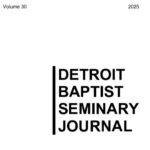Does Matthew 24 Describe the Rapture of the Church (Part 5)?
This series has been looking at nine arguments made by John Hart in Evidence for the Rapture for a pre-tribulation rapture in Matthew 24. So far, in Part 1, we have seen that there is a switch at 24:36 from a gathering of believers that comes after signs (vv. 29–31) to a gathering that comes suddenly without signs (vv. 37–41). In Part 2, we saw that a transition in verse 36 to another question is also indicated by the opening phrase used by Matthew (“Now concerning…” in the ESV). Jesus’ Olivet Discourse is not meant to be read from beginning to end as a chronological account of the future. When he gets to verse 36, Jesus is not describing a series of events within the End as he was earlier, but the arrival of the Day of the Lord as a complex of events, which he calls, in verse 36, “that day or hour” (Part 3). In Part 4, we saw that at least two other factors support this interpretation of Matthew 24:37–41, i.e., that it is a description of the unexpected onset of the Day of the Lord and not a gathering of believers after that Day’s judgments had already been begun. First, the initial arrival of the Day of the Lord would more closely match the sudden arrival of the Flood (vv. 37–39). Second, Jesus’ description of the arrival of that Day in Matthew 24 seems to parallel Paul’s teaching in 1 Thessalonians 5 when he describes Jesus’ coming, the Day of the Lord, as something that arrives suddenly and catches the world off guard.
Arguments #6: Peter’s Teaching
At this point, I believe that two of Hart’s additional arguments can be discussed together. First, the Apostle Peter may, like Paul, base some of his teaching on Jesus’ Olivet Discourse. Hart argues that 1 Peter 3:21 refers indirectly to Noah’s ark, which was mentioned in verse 20. Peter’s point in verse 21 is that Spirit baptism has an antitypical relationship to the ark since it places believers into the body of Christ, which results in deliverance from the coming tribulation. However, the Greek syntax and proper translation and interpretation of 1 Peter 3:21 is notoriously difficult. It seems more likely that Peter is referring to water baptism, which symbolizes death (as in the Flood) but also symbolizes another aspect of our union with Christ, i.e., our resurrection with Christ (“It saves you by the resurrection of Jesus”). This is the first time that I was unpersuaded by one of Hart’s major arguments. It very well could be that we should see the rescue of Noah’s family as a picture of the coming rapture of believers, but I don’t think that is Peter’s point here.
However, in two other places in his writing, Peter does seem to say things that would support Hart’s conclusions regarding Matthew 24. In 2 Peter 2:9, after having discussed how God rescued Noah from the Flood and Lot from Sodom (notice how Noah and Lot both appear in Luke 17:26–37’s version of Mathew 24:37–44), Peter reminds us that the “Lord knows how to rescue the godly from…” and then includes a word (πειρασμός), which could refer not merely to “trials” plural (as in NIV, CSB, ESV, NET) or “temptation” generally (as in NASB), but a specific eschatological trial or tribulation as in Revelation 3:10. In other words, Peter could be saying that God will rescue us from The trial or tribulation. The singular noun and the context regarding Noah and Lot would support the notion that Peter is thinking of a similar rescue of God’s people from a larger coming judgment. That he likened this rescue to the days of Noah and Lot would be consistent with Jesus’ teaching in Matthew 24 (and especially in Luke 17).
Argument #7: The Thief Imagery
2 Peter also refers to Noah in chapter 3, which leads to a second argument made by Hart (this is #8 in Hart’s essay; we will come back to his #7). Peter, along with Paul, uses the image of a thief to describe the coming of the Day of the Lord. After having described the Flood in 2 Peter 3:5–7, Peter moves to a discussion of the Day (vv. 8–11) and reminds us that it will “come like a thief” (v. 10). When addressing believers, Jesus likens his coming to a thief (Luke 12:39; and later in Rev 3:3; 16:15), and he also compares the Day of the Lord to the arrival of a thief (Matt 24:43). This image is not present in the OT and does not appear to come from any intertestamental Jewish literature, so it is reasonable to conclude that Peter and Paul are borrowing the image from their Lord.
All of these passages also seem to be using the image consistently to refer to something that arrives suddenly and without prior warning. A thief never texts you and says he is on his way! If Jesus can speak of his arrival to gather Christians as imminent and the arrival of the Day of the Lord as imminent (“You also must be ready, because the Son of Man will come at an hour when you do not expect him,” Luke 12:40; NIV), this seems to indicate that both things happen together. You could argue that all of these passages are merely saying that the Day of the Lord arrives suddenly, with no implication for the timing of the rapture. However, in Matthew 24 the thief imagery is used immediately after Jesus describes the separation of people into two groups, so the arrival of the “thief” and the separation appears to happen together.
These arguments remind us that we should not interpret Matthew in isolation from other Scripture, including Luke’s account of Jesus’ prophetic teaching. Although Hart does not add this to his argument, Luke’s Olivet Discourse ends with an appeal from Jesus to “pray that you may be able to escape all that is about to happen, and that you may be able to stand before the Son of Man” (21:36; NIV). This paragraph in Luke (21:34–36) has many similarities to Paul’s teaching in 1 Thessalonians 5:1–8 (read the two side-by-side) and so appears to be referring to the same coming Day. Therefore, along with Peter’s statement that the Lord is able to rescue us from this coming trial, Luke’s Olivet Discourse seems to be encouraging us to pray for that exact promise to be fulfilled.



